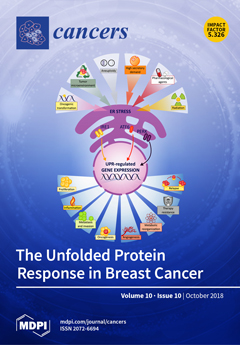Aberrant DNA methylation is a potential mechanism underlying the development of colorectal cancer (CRC). Thus, identification of prognostic DNA methylation markers and understanding the related molecular functions may offer a new perspective on CRC pathogenesis. To that end, we explored DNA methylation profile changes in CRC subtypes based on the microsatellite instability (MSI) status through genome-wide DNA methylation profiling analysis. Of 34 altered genes, three hypermethylated (epidermal growth factor,
EGF; carbohydrate sulfotransferase 10,
CHST10; ependymin related 1,
EPDR1) and two hypomethylated (bone marrow stromal antigen 2,
BST2; Rac family small GTPase 3,
RAC3) candidates were further validated in CRC patients. Based on quantitative methylation-specific polymerase chain reaction (Q-MSP),
EGF,
CHST10 and
EPDR1 showed higher hypermethylated levels in CRC tissues than those in adjacent normal tissues, whereas
BST2 showed hypomethylation in CRC tissues relative to adjacent normal tissues. Additionally, among 75 CRC patients, hypermethylation of
CHST10 and
EPDR1 was significantly correlated with the MSI status and a better prognosis. Moreover,
EPDR1 hypermethylation was significantly correlated with node negativity and a lower tumor stage as well as with mutations in B-Raf proto-oncogene serine/threonine kinase
(BRAF) and human transforming growth factor beta receptor 2 (
TGFβR2). Conversely, a negative correlation between the mRNA expression and methylation levels of
EPDR1 in CRC tissues and cell lines was observed, revealing that DNA methylation has a crucial function in modulating
EPDR1 expression in CRC cells.
EPDR1 knockdown by a transient small interfering RNA significantly suppressed invasion by CRC cells, suggesting that decreased EPDR1 levels may attenuate CRC cell invasion. These results suggest that DNA methylation-mediated
EPDR1 epigenetic silencing may play an important role in preventing CRC progression.
Full article


